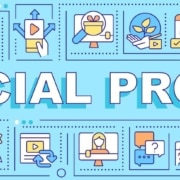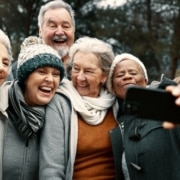Are You Maximizing Your Senior Living Marketing Budget?

The success of your senior living marketing—whether in-house or outsourced—is measured by tours, deposits, and move-ins. While it might be tempting to think your marketing is “working” as long as those three things consistently trend upwards, you could be leaving money on the table and not even realize it.
Budget season is the perfect time for a gut check. Here’s what to do . . .
Review your traffic and conversion sources.
As the saying goes, you can’t manage what you don’t measure. Questions to ask:
- Do you have complete visibility into each of your marketing channels, including digital and traditional?
- Are you using UTM tags properly so you know where people are coming from and how, when, and where they convert?
- Do you use centralized marketing technology, like HubSpot or something similar, that empowers you to monitor traffic sources and campaigns throughout the prospect’s journey?
- Does your marketing tech integrate with your CRM? If not, the two systems won’t communicate, leading to disjointed data.
By asking these questions, you can identify areas you need to fix or improve. For example, if you recently launched an email marketing campaign, but the tracking is broken or non-existent, you won’t know if the campaign is working—or how well.
Or maybe your website traffic and conversion sources are not aligned or a historically successful source of qualified leads is trending down.
Again, these things can be subtle and easy to miss, especially if conversions seem good and the sales team appears happy. You must be proactive, pop the hood, and see what’s what. If you don’t, you might lose out on viable leads that could turn into tours, deposits, and move-ins.
Evaluate your content’s performance.
You need content for all phases of the buyer’s journey. However, too many marketing teams fall into the trap of thinking that the most popular content produces the most conversions.
That’s not always the case, which is why it’s essential to understand which pieces of content drive the most tours, deposits, and move-ins.
For example, guides like “How to fund senior living” tend to be top downloads for many communities. But the question is, how many of the people who download the funding guides ultimately convert into move-ins?
With some of our clients, we’ve discovered that when we look at the people who’ve moved in and best reflect the ideal customer profile, another piece of content—like a decision-making toolkit—actually converts more move-ins.
Intel like this can help you adjust and optimize your content marketing strategy. This is why you shouldn’t get hung up on vanity metrics like most downloads. Instead, always consider which content (and which content paths) produce the best conversions to tours, deposits, and move-ins.
Assess your budget allocation, look for wasteful spending, and adjust accordingly.
Here’s a four-step process to follow when developing your budget. Doing this will help ensure you’re putting all of your marketing dollars to good use:
- Consider your current budget for each channel (e.g., organic, paid, social, etc.). Remember, the best way to inform future strategy is through current performance.
- Review each channel’s results. And not just contacts and leads—you must know which channels are producing tours, deposits, and move-ins.
- Identify any gaps. What don’t you have in your marketing stack? For example, if you haven’t launched a new version of your website in three years, you probably need a new one or a significant refresh at the very least.
- From there, reallocate your budget accordingly. Put more dollars toward what’s delivering the most tours, deposits, and move-ins.
Now’s also a good time to audit your martech stack for technology and software you’re still paying for but not using. You’re wasting budget that you could be using somewhere else that actually helps generate more leads—and ultimately tours, deposits, and move-ins.
- PRO TIP: Communities often wonder how to split their budget between digital and traditional marketing. This will depend on various factors, including the care level you’re selling, what type of community you have (rentals vs. life plan communities, for example), and even location. A rule of thumb: for-profit properties, an 80/20 split makes sense. For non-profits, a 70/30 split works (these communities tend to send more direct mail).
Understand and monitor key metrics.
Do you know the lifetime value of a resident? If not, tackle that first. It’s the granddaddy of all metrics.
Make sure you’ve set up clear goals and conversion tracking:
- Define and track specific conversion goals, such as form submissions or phone calls.
- Analyze conversion funnels to identify potential drop-off points. (More on drop-offs below.)
- Implement tracking codes and pixels for accurate measurement.
Analyze demographic and behavioral data:
- Explore demographic insights of website visitors and email subscribers.
- Analyze user engagement based on age, location, and interests.
- Use this data to refine your buyer personas and marketing messages for them.
Pay attention to funnel drop-off points:
- Identify stages in the conversion funnel with high drop-off rates.
- Analyze user behavior, messaging, or design issues causing drop-offs.
- Optimize those specific areas to improve conversion rates.
Remember, the above items still matter if you work with an outside senior living marketing agency.
The primary difference is that you’ll collaborate with the agency about these items.
If you’re questioning whether your agency is the right fit and delivering measurable ROI, you should take a step back and evaluate their work—and your relationship with the account team.
Remember, a good agency will:
- Create custom dashboards that highlight the metrics that matter most in achieving your goals
- Be proactive in delivering reports, analysis, and recommended adjustments
- Not be afraid to make changes based on what the data says
- Act like a partner rather than a vendor
Some communities might find the agency’s results OK, but the customer service is severely lacking. You shouldn’t have to sacrifice one for the other. A good agency will value its relationship with you and promptly respond to emails, calls, and requests.
Still not sure you have the right agency?
Check out eight signs it might be time to fire your senior living marketing agency. Or you can simply contact us! We value our client relationships and love getting great results for them.




















